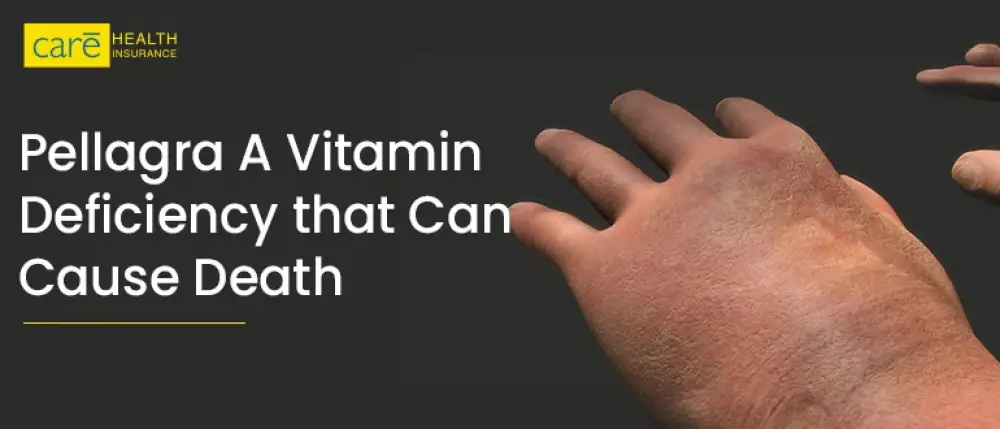Subscribe to get weekly insights
Always stay up to date with our newest articles sent direct to your inbox
Published on 25 Nov, 2024
Updated on 27 Mar, 2025
468 Views
4 min Read

Written by Farina Khan
1Like
Pellagra is caused by a severe deficiency of niacin i.e., vitamin B3. Though less common today, it still quietly affects vulnerable communities across the globe. In this blog, we will take you through the meaning and definition of pellagra, treatment and much more. Keep reading further to know and understand pellagra in detail.
Pellagra, often termed as 4 Ds (Diarrhoea, Dermatitis, Dementia, and Death), is a form of malnutrition. It is a systematic disease that is caused by the deficiency of niacin (Vitamin B3) or its precursor, tryptophan in the diet. Niacin (Vitamin B3) is important to convert the food we eat into energy. It is also important for healthy skin, proper brain functioning, and a healthy digestive system.
Pellagra gained attention in the early 18th century, when it was endemic among Spanish and Italian peasants. These peasants were having high-maize and low-protein diets. It was earlier called 'mal de la rosa' and often mistaken for leprosy. The term pellagra was coined by Frapolli in 1771, where ‘pelle’ is an Italian word meaning skin and ‘agra’ meaning rough.
Pellagra symptoms can be categorised into four types: diarrhoea, dermatitis, dementia, and eventually death, if left untreated. Check out the pellagra symptoms here:
Now, as the meaning and definition of pellagra is well established, let's understand what causes pellagra. The underlying causes of primary and secondary pellagra are quite different. Primary pellagra is caused by taking a low niacin diet and mainly relying on maize. On the flip side, people who can’t absorb vitamin B3 may develop secondary pellagra. The alcohol can prevent the body from absorbing niacin.
Various other causes of pellagra may include malnutrition from homelessness, anorexia, HIV, or end stage cancer, Crohn’s disease, Hartnup disease, dialysis, or certain drugs, such as isoniazid for tuberculosis, and carcinoid syndrome, a collection of symptoms due to carcinoid tumours.
Three types of people are generally at risk of pellagra:
It is easy to diagnose pellagra in the patients who are suffering from all three Ds including diarrhoea, dermatitis, and dementia. However, if these pellagra symptoms do not show up at the same time, the diagnosis of pellagra may be difficult. The physician may do a physical examination and if not able to diagnose, urine and blood may be suggested.
Well, if you are wondering is Pellagra treatable? The good news is pellagra is treatable and recovery can be swift with extra care and attention. Niacin or Nicotinamide are some of the most common supplements given to the patients to treat pellagra.
Few dietary changes like including niacin-rich food in the diet may be suggested by the doctor. You may include meat, eggs, fish, and legumes, such as peas and lentils in your diet. Treating alcoholism or digestive disorders is the most important way to treat pellagra.
The World Health Organisation recommends at least 300 mg nicotinamide in an oral divided dose to treat pellagra. This oral divided dose should be taken up to 3-4 weeks to cure and treat pellagra. .
If the niacin supplements are not taken as prescribed, side effects may occur. Some of the side effects of pellagra that may occur due to overdose include:
Food plays an important and vital role in preventing pellagra. To prevent pellagra, enriched foods and dietary supplements can help a lot. The best food sources of niacin include beef liver, beets, brewer's yeast, enriched bread and cereals, oily fish, such as salmon and tuna, peanuts, potato, poultry, rice, sunflower seeds, and spaghetti sauce. Apart from the food source some additional supplements and medications with doctors recommendations is also advisable.
While pellagra is very rare in developed countries but it is quite concerning in impoverished regions. Humanitarian organisations play an important role in providing nutritional aid to vulnerable populations. This can ensure access to diverse diets rich in essential vitamins that are actually important for the body.
>>Read More: All You Need to Know about the Types of Nutrition
Pellagra - a forgotten nutritional disorder is a reminder of how crucial and important it is to have a balanced diet. Although medical advancements and awareness have reduced its prevalence, it is still important to keep discussing these kinds of issues to support the people who are still at risk.
Additionally, consider investing in a comprehensive health plan from Care Health Insurance that covers almost everything from hospitalisation expenses to daycare treatment coverage.. The dedicated and personalised plans that cover doctor consultation and nutritionist appointments will surely be an advantage for you.
Disclaimer: The above information is for reference purposes only. Kindly consult your general physician for verified medical advice. The health insurance benefits are subject to policy terms and conditions. Refer to your policy documents for more information.
शुगर कंट्रोल कैसे करे? जानें, डायबिटीज में क्या खाना चाहिए Care Health Insurance in Health & Wellness
Thyroid : मामूली नहीं हैं महिलाओं में थायराइड होना, जानें इसके लक्षण और घरेलू उपचार Care Health Insurance in Diseases
हाई ब्लड प्रेशर को तुरंत कंट्रोल कैसे करें? देखें इसके उपाय Care Health Insurance in Diseases
प्लेटलेट्स की कमी के लक्षण, कारण और इलाज क्या है Care Health Insurance in Diseases
What is Endocrinology? Hormones, Disorders & Treatment Care Health Insurance in Diseases
Do People with Mental Illness Have Less Heart Disease? Care Health Insurance in Diseases
एक्जिमा क्या है? देखें, इसके लक्षण और इलाज Care Health Insurance in Diseases
Guillain-Barré Syndrome (GBS): Causes, Symptoms and Treatment Care Health Insurance in Diseases